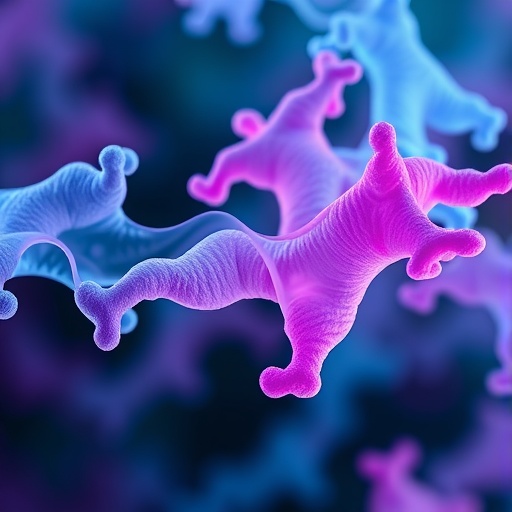
In a groundbreaking convergence of artificial intelligence and molecular pharmacology, researchers have unveiled Bufalin as a novel molecular glue degrader targeting the estrogen receptor alpha (ERα), a critical driver in many hormone-responsive cancers. This innovative discovery, recently published in Nature Communications, showcases how cutting-edge computational strategies can accelerate the drug discovery process, especially in the elusive domain of protein degradation. The implications of this work not only promise new therapeutic avenues for estrogen receptor-positive cancers but also underscore the transformative potential of AI in reshaping pharmaceutical research.
Estrogen receptor alpha, a nuclear hormone receptor, plays a pivotal role in the development and progression of breast cancer. Its aberrant activation drives tumor growth, making ERα a prime target for therapeutic intervention. Current treatments often involve selective estrogen receptor modulators or degraders; however, resistance mechanisms frequently emerge, limiting their long-term efficacy. This scenario has propelled scientists to seek alternative strategies that can modulate ERα stability and function more effectively. Bufalin, a steroid compound derived from traditional Chinese medicine, emerged as an intriguing candidate through a sophisticated AI-driven discovery pipeline.
The use of artificial intelligence in drug discovery represents a transformative shift in biomedical sciences. Traditional experimental methods are labor-intensive and time-consuming, often involving trial-and-error screening of vast chemical libraries. In contrast, AI algorithms can rapidly analyze complex biological and chemical datasets, identifying promising molecules with desired biological activities. In this study, the research team deployed advanced machine learning models designed to predict molecular glues — small molecules that facilitate protein-protein interactions leading to targeted protein degradation. By leveraging extensive databases of molecular structures and interaction profiles, AI identified Bufalin as a potential mediator capable of inducing ERα degradation.
.adsslot_gvAk1Jr4tM{width:728px !important;height:90px !important;}
@media(max-width:1199px){ .adsslot_gvAk1Jr4tM{width:468px !important;height:60px !important;}
}
@media(max-width:767px){ .adsslot_gvAk1Jr4tM{width:320px !important;height:50px !important;}
}
ADVERTISEMENT
Molecular glues have garnered significant attention as an innovative class of therapeutic agents. Unlike classical inhibitors that block active sites, molecular glues facilitate new interactions between target proteins and the cellular degradation machinery, effectively tagging the protein for destruction. This mechanism allows for highly selective modulation of protein levels within the cell. Bufalin’s identification as a molecular glue is particularly noteworthy because it opens new directions in modulating challenging targets like nuclear receptors, which have traditionally been difficult to drug due to their complex regulation and conformational dynamics.
The researchers employed a multi-layered validation approach to confirm Bufalin’s activity. Initial computational predictions were followed by biophysical and biochemical assays that demonstrated Bufalin’s ability to bridge ERα with E3 ubiquitin ligases, the enzymes responsible for tagging proteins for proteasomal degradation. Structural analyses, including cryo-electron microscopy and mass spectrometry, elucidated the tri-molecular complex formed by Bufalin, ERα, and the ligase, revealing the molecular basis of the induced proximity effect. These findings confirm that Bufalin does not merely inhibit ERα but promotes its active ubiquitination and subsequent degradation.
Beyond the mechanistic insights, cell-based experiments unveiled the functional consequences of Bufalin-induced ERα degradation. Cancer cell lines reliant on ERα signaling exhibited marked decreases in proliferation upon Bufalin treatment. Moreover, transcriptional profiling revealed downstream attenuation of estrogen-responsive genes, corroborating the effective dismantling of ERα-mediated signaling pathways. Importantly, comparative studies indicated that Bufalin’s mode of action differed fundamentally from existing selective estrogen receptor degraders (SERDs), potentially circumventing common resistance pathways.
One of the remarkable aspects of this research is its demonstration of AI’s role in unearthing bioactive natural products with previously unrecognized mechanisms. Bufalin had been studied mainly for its cardiotonic and anti-inflammatory properties; however, its capacity as a molecular glue expands its therapeutic relevance substantially. This finding exemplifies how AI can bridge traditional knowledge with modern molecular pharmacology, offering a new lens through which to explore natural compound libraries for drug discovery.
The study also highlights the importance of integrative approaches combining computational predictions with experimental validations. While AI can prioritize candidates rapidly, empirical evidence remains critical to decipher complex biological interactions and to understand pharmacodynamics and toxicity profiles. The researchers’ comprehensive methodology, encompassing in silico modeling, biochemical assays, and cellular analyses, set a rigorous standard for future work in this rapidly evolving field.
Bufalin’s potential therapeutic application extends into breast cancer treatment paradigms where hormone receptor status is a critical determinant. Since ERα-positive breast cancers constitute a majority of breast cancer diagnoses worldwide, the introduction of a molecular glue degrader offers a desperately needed option, especially for patients who develop resistance to endocrine therapies. Future clinical investigation will be necessary to evaluate Bufalin’s safety, efficacy, and pharmacological characteristics in vivo, but the preclinical results are undeniably promising.
This research also paves the way for the discovery of other molecular glue degraders targeting a broad spectrum of disease-relevant proteins. By refining and expanding AI models, the identification process can be diversified and accelerated, potentially transforming how pharmaceutical companies approach ‘undruggable’ targets. The modular nature of molecular glues allows for tailored interventions designed for selective degradation, reducing off-target effects and improving patient outcomes.
The discovery of Bufalin as an ERα molecular glue degrader exemplifies how blending AI with molecular biology can overcome longstanding drug development hurdles. This paradigm shift in drug design has far-reaching implications beyond oncology, potentially influencing treatments for neurodegenerative diseases, immune disorders, and viral infections, where aberrant protein regulation plays a pathogenic role. By targeting protein stability rather than merely function, clinicians may gain access to a new class of interventions with greater specificity and durability.
Furthermore, the study emphasizes the significance of multidisciplinary collaboration. Chemists, biologists, data scientists, and clinicians joined forces to translate AI-generated hypotheses into tangible experimental evidence. Such collaborative ecosystems are essential for harnessing the full power of AI-enhanced drug discovery, ensuring that computational advances are grounded in biological reality and clinical relevance.
In addition to its scientific merit, this breakthrough carries profound implications for drug affordability and accessibility. Artificial intelligence enables more cost-effective exploration of chemical space, potentially shortening timelines and reducing expenses associated with bringing novel therapeutics to market. This could democratize access to cutting-edge treatments, particularly for diseases with high unmet medical needs like hormone receptor-positive breast cancer.
Looking forward, the integration of AI-driven methods with emerging technologies such as single-cell proteomics, CRISPR screens, and high-throughput structural biology could further revolutionize our understanding of protein interactions and degradation pathways. Bufalin’s identification as a molecular glue may represent just the tip of an iceberg, with many more druggable mechanisms awaiting discovery through sophisticated computational and experimental synergies.
In conclusion, harnessing artificial intelligence to uncover Bufalin as a molecular glue degrader of estrogen receptor alpha represents a landmark achievement in contemporary biomedical research. This study not only sheds light on a novel mechanism to combat hormone-driven cancers but also showcases the transformative power of AI-guided drug discovery. As the pharmaceutical landscape evolves, the fusion of computational ingenuity with biological insight promises to unlock new frontiers in disease treatment, heralding an era of more precise, effective, and personalized medicine.
Subject of Research: Identification of Bufalin as a molecular glue degrader targeting estrogen receptor alpha using artificial intelligence.
Article Title: Harnessing artificial intelligence to identify Bufalin as a molecular glue degrader of estrogen receptor alpha
Article References:
Jiang, S., Liu, K., Jiang, T. et al. Harnessing artificial intelligence to identify Bufalin as a molecular glue degrader of estrogen receptor alpha. Nat Commun 16, 7854 (2025). https://doi.org/10.1038/s41467-025-62288-7
Image Credits: AI Generated
Tags: AI drug discoveryartificial intelligence in pharmacologybreast cancer treatment innovationsBufalin estrogen receptor degradercomputational strategies in drug developmentestrogen receptor alpha targetinghormone-responsive cancer therapiesmolecular glue degradersnovel therapeutic avenues for cancersovercoming drug resistance in cancerprotein degradation strategiestraditional Chinese medicine in pharmacology





